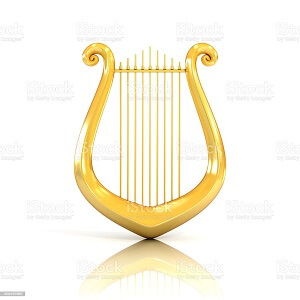Lyre
 The lyre was a stringed musical instrument played by the ancient Greeks and was probably the most important and well-known instrument in the Greek world. It was closely related to the other stringed instruments: the chelys which was made from a tortoise shell, the four-stringed phorminx, and the seven-stringed kithara.
The lyre was a stringed musical instrument played by the ancient Greeks and was probably the most important and well-known instrument in the Greek world. It was closely related to the other stringed instruments: the chelys which was made from a tortoise shell, the four-stringed phorminx, and the seven-stringed kithara.
In Greek mythology, all four instruments are often named interchangeably in various myths, and Hermes is generally credited with their invention. The messenger god made the instrument from a tortoise shell, gut, and reeds, principally to help him steal 50 prize cattle from Apollo's sacred herd. Apollo discovered the theft and was only placated by Hermes' offer of the lyre. Apollo, from that point on, was considered the player par excellence of the lyre. Apollo also taught that other great mythical musician, Orpheus, how to play the instrument which would become his emblem. Orpheus was believed to be Thracian, which helped reinforce the belief that the lyre had its origins there. However, the invention of the seven-string version of the lyre is credited to Terpander of Lesbos. Other mythical figures often seen with a lyre include Eros and the Muses.
TThe stringed instrument usually had two fixed upright arms (pecheis) or horns (kerata) and a crossbar (zygos) with tuning pegs (kollopes) of bronze, wood, ivory, or bone. Seven strings (neurai or chordai) of equal length but varying thickness (usually made from sheep gut) stretched between the crossbar and a fixed tailpiece (chordotonon) and were played by strumming or plucking by hand, usually using a plectrum made of wood, ivory, or metal.